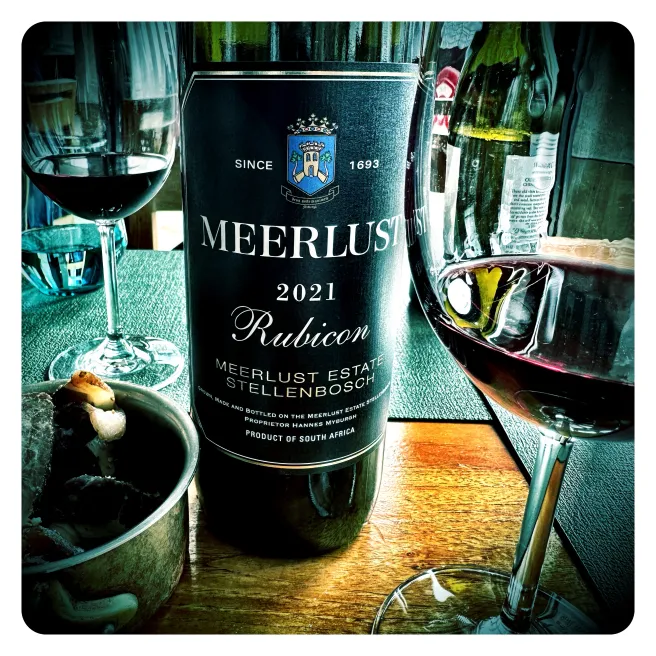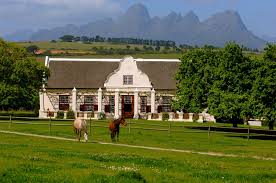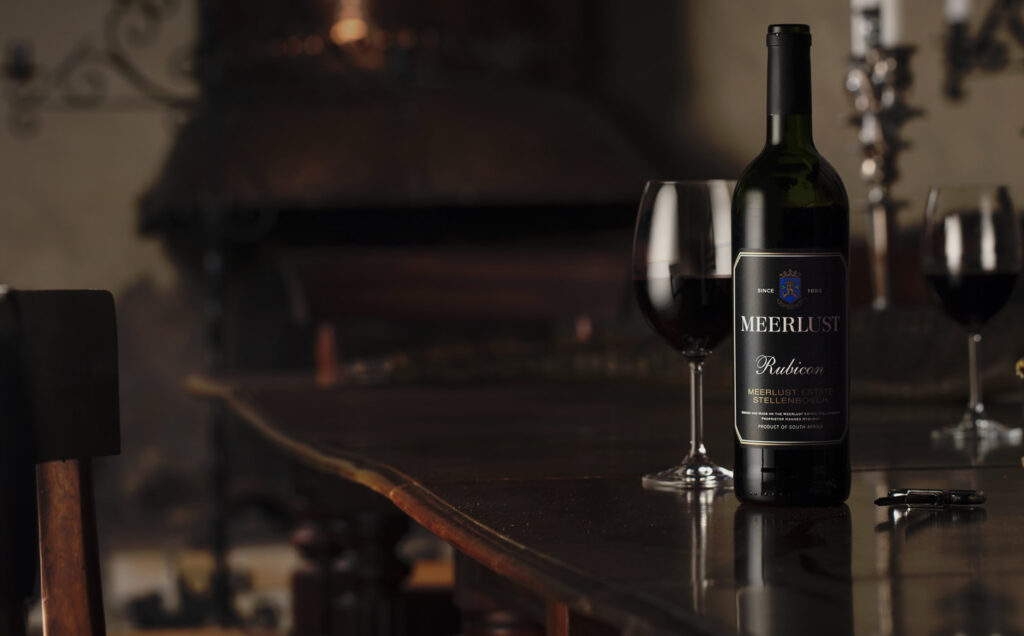
As I wound my way along Baden Powell Drive, the iconic palm-lined entrance of Meerlust Wine Estate came into view, framed by Stellenbosch’s rolling hills and the distant shimmer of False Bay. For a wine blogger at CapeVineMaster.co.za, visiting Meerlust was like stepping into a chapter of South African wine history. This 17th-century national monument, owned by the Myburgh family since 1756, is synonymous with world-class wines, particularly its legendary Rubicon blend. My day at Meerlust was a journey through time, terroir, and taste, with a tasting room experience that balanced tradition with modern flair. From its storied past to its meticulously crafted wines and serene estate activities, Meerlust delivers a masterclass in winemaking—though a few areas could use a touch more polish. Join me as I uncork the story of Meerlust, its vines, its vintages, and the pleasures awaiting visitors.
A Heritage Steeped in Tradition
Meerlust’s story begins in 1693, when German immigrant Henning Huising settled on a granite outcrop just 5 km from False Bay, naming his new home “Meerlust,” or “pleasure of the sea,” for its coastal breezes. In 1756, Johannes Myburgh purchased the estate, launching a family legacy that now spans eight generations. Today, Hannes Myburgh, a trained winemaker who studied at Geisenheim and Château Lafite, upholds this tradition as the estate’s custodian, alongside Cellar Master Wim Truter, appointed in 2020 after stints at KWV and global wineries.
The estate’s 300-year history is etched into its Cape Dutch manor house, a national monument since 1987, complete with rose gardens, a family cemetery, dovecote, and bird sanctuary. In the 1960s, Nico Myburgh, Hannes’s father, revolutionized South African winemaking by drawing parallels between Stellenbosch’s terroir and Bordeaux’s, inspiring the creation of Rubicon in 1980—a pioneering Bordeaux-style blend that put Meerlust on the global map. The estate’s 200 hectares of vineyards, cooled by ocean mists and rooted in deep Hutton and Clovelly soils, produce grapes with concentrated flavors, making Meerlust a beacon of elegance and innovation. My only quibble? The estate’s rich history could be better showcased; a guided historical tour would bring the Myburgh saga to life for visitors.
Vineyards and Varieties: A Terroir Triumph
Meerlust’s vineyards are a study in precision, with each cultivar planted to maximize its potential. Merlot thrives in the richest clay soils, while Cabernet Sauvignon and Cabernet Franc flourish on gravelly granite for warmth and drainage. Petit Verdot grows on north-facing slopes, and Pinot Noir occupies the coolest corners to preserve finesse. Chardonnay, the estate’s sole white grape, is planted near the Eerste River on well-drained soils. The maritime climate, with summer breezes and evening mists from False Bay, ensures slow ripening, yielding grapes with intense varietal character.
The estate grows six key varieties:
- Cabernet Sauvignon: The backbone of Rubicon, offering structure and dark fruit.
- Merlot: Adds plushness and ripe fruit to blends.
- Cabernet Franc: Contributes elegance and herbal notes.
- Petit Verdot: A small but spicy addition for complexity.
- Pinot Noir: Delivers finesse and red fruit in cooler sites.
- Chardonnay: The only white, known for its balance and subtle oak.
These cultivars, hand-harvested from 200 hectares, reflect Meerlust’s commitment to estate-grown wines, a rarity in South Africa shared by only a few, like Muratie. The soils, akin to Bordeaux’s decomposed granite and clay, provide drought resistance and depth, crafting wines of exceptional complexity.
The Wines: A Symphony of Sophistication
Meerlust’s portfolio, crafted under Wim Truter’s meticulous eye, is a showcase of refined reds and one stellar white. The flagship Rubicon, a Cabernet Sauvignon-led blend with Merlot, Cabernet Franc, and Petit Verdot, is only produced in top vintages, with lesser years declassified to the Meerlust Red (as in 2019). Here’s what I tasted:
- Rubicon 2020: A masterpiece of dark plum, violets, and cedar, with silky tannins and a mineral backbone. It’s world-class but demands patience to reach its peak.
- Cabernet Sauvignon: Rich with cassis and chocolate, structured yet approachable. A touch more fruit purity would make it sing.
- Merlot 2020: Opulent with mulberry and liquorice, softened by Cabernet Franc and Petit Verdot. Approachable yet complex, it’s a standout.
- Pinot Noir: Vibrant red cherry and elegant tannins. Youthful and fresh, it’s more approachable than some coastal Pinots but less intense.
- Chardonnay 2023: The lone white, with citrus, apple, and subtle oak. Balanced and refined, though I craved a bit more intensity to rival top Burgundies.
- Meerlust Red 2020: A declassified blend with dark fruit and herb notes. Great value at a lower price point, but it lacks Rubicon’s finesse.
The wines, aged in French oak (new and second-fill), reflect Meerlust’s Bordeaux-inspired ethos, with each vineyard block fermented separately for precision blending. Priced from R300 to R600, they’re premium but fair for the quality, with Rubicon a collector’s gem. My critique? Some reds lean heavily on oak, occasionally masking fruit vibrancy. A lighter touch could elevate their already stellar profile.




The Tasting Room: A Cozy Dive into History
The tasting room, housed in the wine shop, is a highlight, offering a relaxed yet intimate experience led by staff like Trish and Annemarie. For R75 per person (refundable with purchase), the standard tasting includes the full range, from Chardonnay to Rubicon, served in a cozy space adorned with a photographic timeline of Meerlust and Cape history. The VIP tasting (R250, booking required) ups the ante, held in a private room with senior staff pouring current and older vintages, like a 2005 Merlot, in Riedel glassware.
My standard tasting was a delight, with Carole, the manager, sharing insights into Rubicon’s creation. Her passion was infectious, though the small room felt cramped when another group arrived. The wines were paired with simple nibbles (olives and bread), but I longed for a curated food pairing, like cheese or charcuterie, to complement the reds. The VIP option sounds luxurious, but its high cost and appointment-only nature may deter casual visitors. The shop’s historical display was engaging, yet the lack of a guided manor or cellar tour left me wanting more immersion in Meerlust’s storied past.
Activities to Savor at Meerlust
Meerlust is a wine-focused estate, prioritizing quality over sprawling amenities, but there’s enough to make a visit memorable:
- Wine Tastings: Standard tastings (Mon-Fri 9am-5pm, Sat 10am-2pm, closed Sundays) are relaxed and informative. Groups over 10 need reservations, and private tastings are by appointment.
- VIP Tasting: A premium experience with older vintages in a private room. Book via tasting@meerlust.co.za.
- Estate Exploration: Wander the rose gardens, dovecote, and bird sanctuary, or admire the Cape Dutch manor’s white façade. The oak-lined drive is perfect for photos, though access to the manor is limited.
- Wine Purchases: The shop offers cellar-door prices, with cases at competitive rates. Rubicon and Merlot are popular take-homes.
- Scenic Relaxation: The estate’s proximity to False Bay and Stellenbosch’s hills invites lingering, though no formal picnic areas exist. Nearby Stellenbosch, 20 minutes away, offers dining options, as Meerlust has no restaurant.
The estate’s charm lies in its unpretentious elegance, but activities are limited compared to larger farms. No kids’ facilities or scheduled tours mean it’s best for wine enthusiasts or couples. Some visitors note the tasting room’s small size can feel crowded on busy days, and the lack of food options is a drawback.
A Positive Yet Critical Review
Meerlust Wine Estate is a Stellenbosch icon, blending 300 years of history with wines that rival the world’s best. Rubicon remains a benchmark for South African blends, and the Chardonnay and Merlot showcase the estate’s versatility. The tasting room, with its warm staff and historical touches, offers a personal connection to Meerlust’s legacy, and the estate’s serene beauty—rose gardens, dovecote, and all—is a visual treat. The Myburgh family’s dedication, paired with Wim Truter’s expertise, ensures Meerlust remains a global leader.
However, there’s room for refinement. The tasting room’s small size and lack of food pairings limit the experience, especially for groups. The absence of guided cellar or manor tours feels like a missed opportunity to share Meerlust’s rich narrative. Some wines, while exceptional, could benefit from less oak to let the fruit shine. Accessibility is also a concern—weekend hours are limited, and the VIP tasting’s cost may deter budget-conscious visitors. Finally, the estate’s low-key vibe, while charming, risks feeling underwhelming compared to more commercialized farms.
Final Thoughts
My visit to Meerlust was a pilgrimage to South African wine royalty, leaving me with a bottle of Rubicon, a deeper appreciation for Bordeaux blends, and a longing to return. The estate’s elegance, from its historic manor to its meticulously crafted wines, is undeniable, and the tasting room’s cozy charm makes every sip special. For wine lovers seeking quality over flash, Meerlust is a must-visit, offering a taste of Stellenbosch’s soul just 15 km from town. Book your tasting, savor the sea-kissed terroir, and raise a glass to a legacy that’s only getting better with age. Meerlust isn’t just a winery—it’s a love story between land, family, and wine.
Plan your visit at Meerlust.co.za and join CapeVineMaster.co.za’s monthly tastings for more wine adventures!
